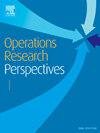How to improve the key component's quality: the impact of overconfident manufacturer's R&D investment
IF 3.7
4区 管理学
Q2 OPERATIONS RESEARCH & MANAGEMENT SCIENCE
引用次数: 0
Abstract
In the EV supply chain, R&D cooperation for key components between the manufacturer and tier 2 supplier is common. This paper primarily explores the effects of cross-echelon R&D cooperation and overconfidence on the quality and price of key components, as well as the profits of the manufacturer and suppliers. We assume that the supply chain consists of one tier 2 supplier, one tier 1 supplier, and one overconfident manufacturer. We first present the wholesale price contract as a benchmark, followed by the two-part contract and the equity contract between the tier 2 supplier and the manufacturer. Additionally, we compare above three contracts and provide numerical examples. We find that (1) the manufacturer's overconfidence level and the contract type jointly affect the quality of the key component and the profit of the tier 1 supplier. When the overconfidence level is low or the manufacturer's shareholding ratio is low, the two-part contract is more effective in improving the key component's quality and the tier 1 supplier's profit. Or else, the equity cooperation contract is more effective in improving the key component's quality and the tier 1 supplier's profit. (2) Under the equity contract, the tier 2 supplier can obtain higher profit, while the manufacturer may achieve higher overestimated expected profit under the two-part contract. (3) Under the two-part contract, the manufacturer's overconfidence increases the component's quality and the profit of the tier 1 supplier, but decreases the profit of the tier 2 supplier. In the other two contracts, the manufacturer's overconfidence leads to a decline in the key component's quality and the profits of both the tier 1 and tier 2 suppliers.
如何提高关键零部件的质量:过度自信制造商研发投入的影响
在电动汽车供应链中,制造商和二级供应商之间的关键部件研发合作是很常见的。本文主要探讨了跨梯队研发合作和过度自信对关键零部件质量和价格以及制造商和供应商利润的影响。我们假设供应链由一个二级供应商、一个一级供应商和一个过度自信的制造商组成。我们首先提出了批发价格合同作为基准,然后是两部分合同和二级供应商与制造商之间的股权合同。此外,对上述三种契约进行了比较,并给出了数值算例。我们发现(1)制造商的过度自信程度和合同类型共同影响关键零部件的质量和一级供应商的利润。当过度自信水平较低或制造商持股比例较低时,两部分合同对提高关键零部件质量和一级供应商利润更有效。否则,股权合作合同对于提高关键零部件的质量和一级供应商的利润更有效。(2)在股权合同下,二级供应商可以获得更高的利润,而在两部分合同下,制造商可能获得更高的高估预期利润。(3)在两部分合同下,制造商的过度自信提高了零部件的质量和一级供应商的利润,但降低了二级供应商的利润。在另外两份合同中,制造商的过度自信导致关键部件的质量下降和一级和二级供应商的利润下降。
本文章由计算机程序翻译,如有差异,请以英文原文为准。
求助全文
约1分钟内获得全文
求助全文
来源期刊

Operations Research Perspectives
Mathematics-Statistics and Probability
CiteScore
6.40
自引率
0.00%
发文量
36
审稿时长
27 days
 求助内容:
求助内容: 应助结果提醒方式:
应助结果提醒方式:


